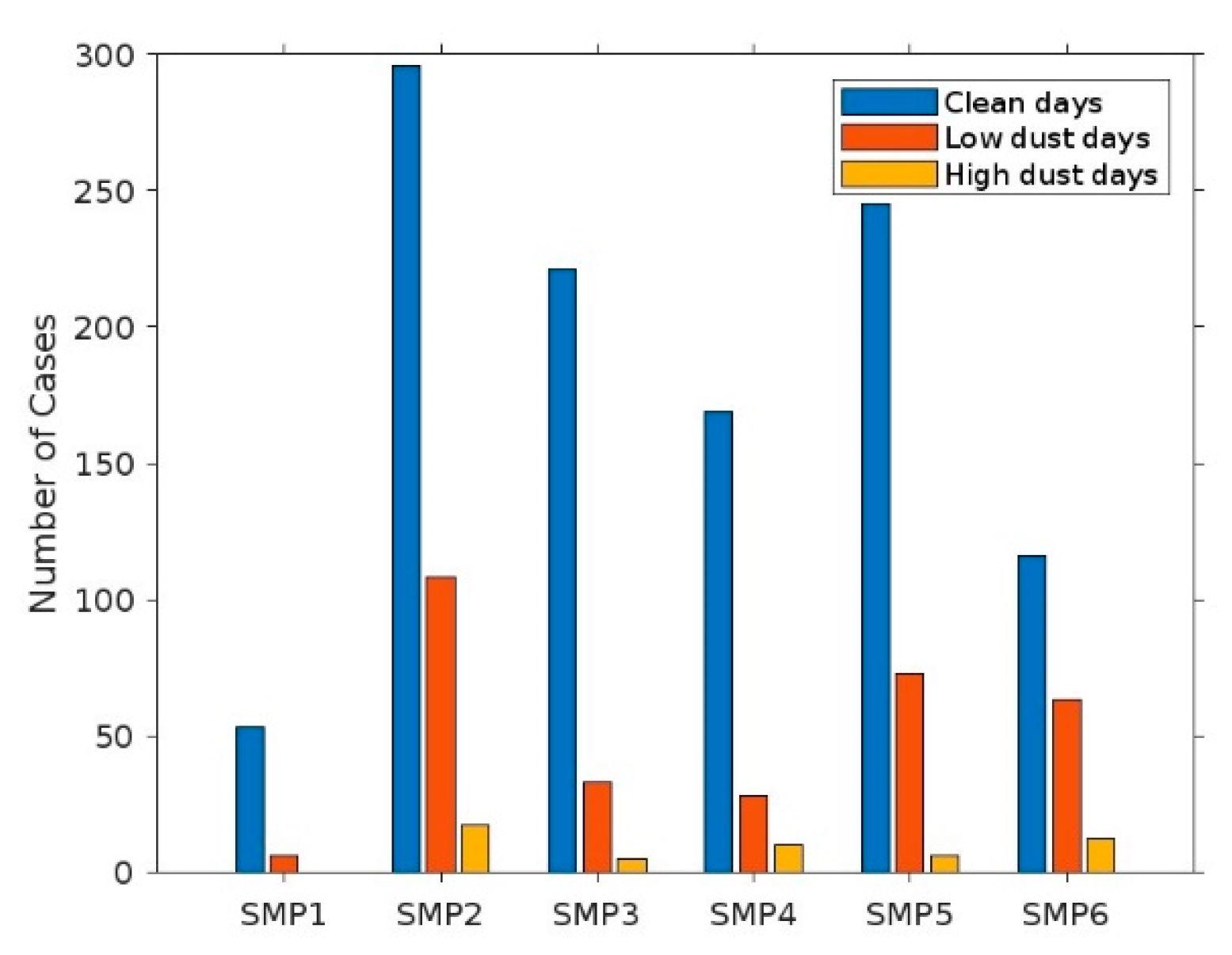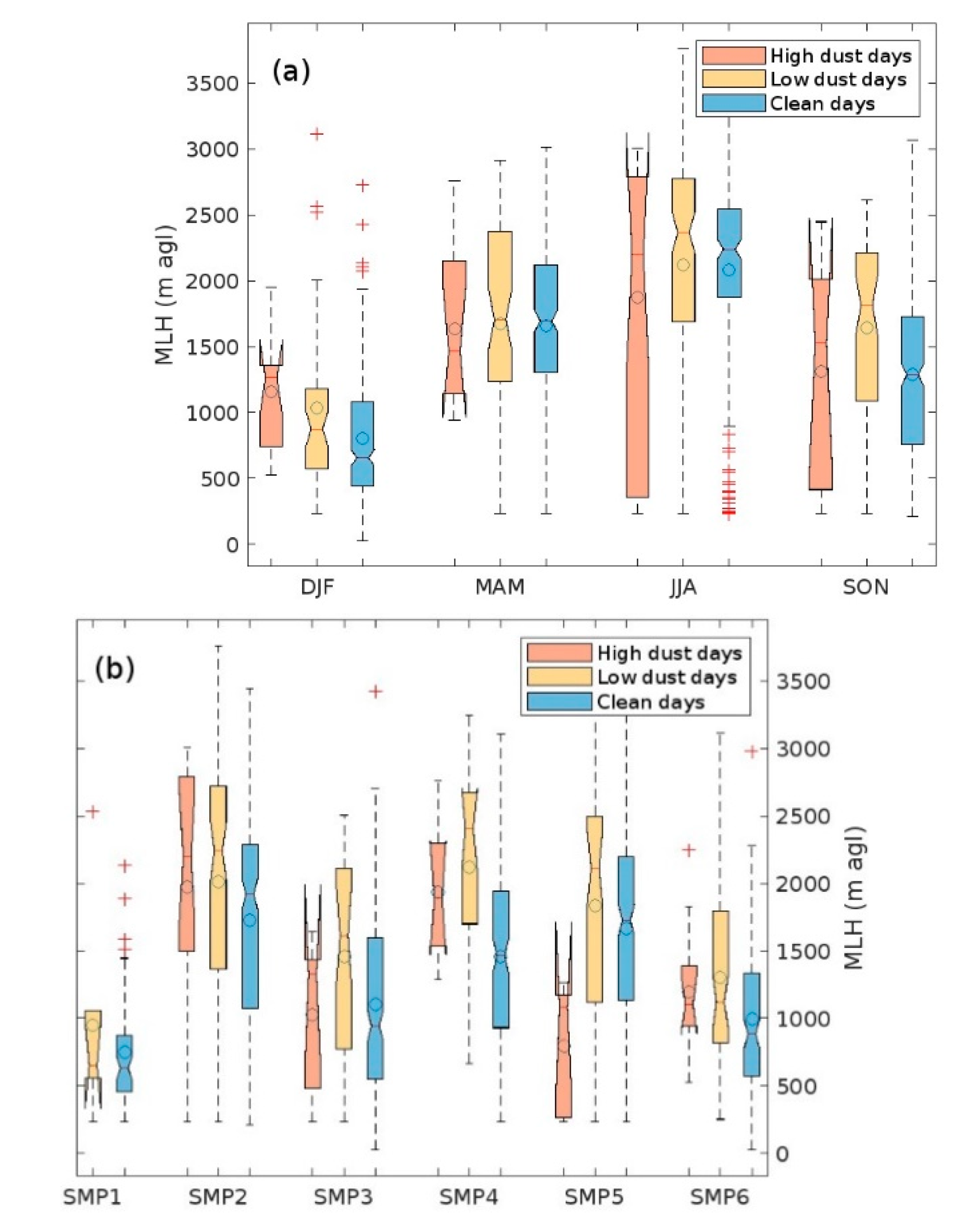Submitted:
04 November 2024
Posted:
04 November 2024
You are already at the latest version
Abstract
Keywords:
1. Introduction
2. Materials and Methods
2.1. Experimental Site
2.2. Instrumentation
2.3. Methodology for Classification of Days Based on Meteorological Fields
2.4. Identification of Saharan Dust Events
3. Results
3.1. Daily Evolution of the ML, Quicklooks and STRATfinder Estimations
3.2. ML Heights Estimation for 2020– 2023
3.3. Effect of Saharan Dust Intrusions on MLHs
4. Discussion
Author Contributions
Funding
Acknowledgments
Conflicts of Interest
References
- Boucher, O.; Randall, D.; Artaxo, P.; Bretherton, C.; Feingold, G.; Forster, P.; Kerminen, V.; Kondo, Y.; Liao, H.; Lohmann, U.; et al. Clouds and Aerosols. In Contribution of Working Group I to the Fifth Assessment Report of the Intergovernmental Panel on Climate Change; Cambridge University Press: Cambridge, UK, 2013. [Google Scholar]
- Stull, R.B. An Introduction to Boundary Layer Meteorology. In Atmospheric Sciences Library; Springer: Berlin, Germany, 1988; Volume 8, p. 89. ISBN 978-94-009-3027-8. [Google Scholar]
- Monks, P.S. , Granier, C., Fuzzi, S., Stohl, A., Williams, M.L., Akimoto, H., Amann, M., Baklanov, A., Baltensperger, U., Bey, I., Blake, N., Blake, R.S., Carslaw, K., Cooper, O.R., Dentener, F., Fowler, D., Fragkou, E., Frost, G.J., Generoso, S., von Glasow, R., Atmospheric composition change – global and regional air quality. Atmos. Environ. 2009; 43, 5268–5350. [Google Scholar] [CrossRef]
- Geiß, A.; Wiegner, M.; Bonn, B.; Schäfer, K.; Forkel, R.; von Schneidemesser, E.; Münkel, C.; Chan, K.L.; Nothard, R. Mixing layer height as an indicator for urban air quality? Atmos. Meas. Tech. 2017, 10, 2969–2988. [Google Scholar] [CrossRef]
- Mahrt, L. Stratified atmospheric boundary layers. Bound. Layer Meteorol. 1999, 90, 375–396. [Google Scholar] [CrossRef]
- White, J.M., Bowers, J.F., Hanna, S.R., Lundquist, J.K., Importance of using Observations of Mixing Depths in order to Avoid large Prediction Errors by a Transport and Dispersion Model. J. Atmos. Ocean. Technol. 2009, 26, 22–32. [CrossRef]
- Sailor, D.J. Simulated urban climate response to modifications in surface albedo and vegetative cover. J. Appl. Meteorol. http:// www.jstor.org/stable/26187281. 1995, 34, 1694–1704. [Google Scholar] [CrossRef]
- Seibert, P.; Beyrich, F.; Gryning, S.-E.; Joffre, S.; Rasmussen, A.; Tercier, P. Review and intercomparison of operational methods for the determination of the mixing height. Atmos. Environ. 2000, 34, 1001–1027. [Google Scholar] [CrossRef]
- Stirnberg, R., Cermak, J., Kotthaus, S., Haeffelin, M., Andersen, H., Fuchs, J., Kim, M., Petit, J.-E., and Favez, O.: Meteorologydriven variability of air pollution (PM1) revealed with explainable machine learning, Atmos. Chem. Phys. 2021, 21, 3919–3948. [CrossRef]
- Peña, A., Floors, R., Sathe, A., Gryning, S. E., Wagner, R., Courtney, M. S., Larsén, X. G., Hahmann, A. N., and Hasager, C. B.: Ten Years of Boundary-Layer and Wind-Power Meteorology at Høvsøre, Denmark, Bound.-Lay. Meteorol. 2016, 158, 1–26. [CrossRef]
- Illingworth, A. J. , Cimini, D., Haefele, A., Haeffelin, M., Hervo, M., Kotthaus, S., Löhnert, U., Martinet, P., Mattis, I., O’Connor, E., and Potthast, R.: How Can Existing Ground-Based Profiling Instruments Improve European Weather Forecasts? B. Am. Meteorol. Soc. 2019, 100, 605–619. [Google Scholar] [CrossRef]
- Seidel, D.J.; Ao, C.O.; Li, K. Estimating climatological planetary boundary layer heights from radiosonde observations: Comparison of methods and uncertainty analysis. J. Geophys. Res. 2010, 116, D16113. [Google Scholar] [CrossRef]
- Kotthaus, S. and Grimmond, C.S.B.: Atmospheric boundary-layer characteristics from ceilometer measurements. Part 1: a new method to track mixed layer height and classify clouds. Q J R Meteorol. Soc. 2018, 144, 1525–1538. [Google Scholar] [CrossRef]
- Duncan Jr., J. B., Bianco, L., Adler, B., Bell, T., Djalalova, I. V., Riihimaki, L., Sedlar, J., Smith, E. N., Turner, D. D., Wagner, T. J., and Wilczak, J. M.: Evaluating convective planetary boundary layer height estimations resolved by both active and passive remote sensing instruments during the CHEESEHEAD19 field campaign. Atmos. Meas. Tech. 2022, 15, 2479–2502. [Google Scholar] [CrossRef]
- Wiegner, M. , Madonna F., Binietoglou I., Forkel R., Gasteiger J., Geiß A., Pappalardo G., Schäfer K., and Thomas W.: What is the benefit of ceilometers for aerosol remote sensing? An answer from EARLINET. Atmos. Meas. Tech. 2014, 7, 1979–1997. [Google Scholar] [CrossRef]
- Illingworth, A.J. , Cimini, D., Gaffard, C., Haeffelin, M., Lehmann, V., L¨ohnert, U., O’Connor, E.J., Ruffieux, D. Exploiting existing ground-based remote sensing networks to improve high-resolution weather forecasts. Bull. Am. Meteorol. Soc. 2015, 96, 2107–2125. [Google Scholar] [CrossRef]
- Cazorla, A.; Casquero-Vera, J.A.; Román, R.; Guerrero-Rascado, J.L.; Toledano, C.; Cachorro, V.E.; Orza, J.A.G.; Cancillo, M.L.; Serrano, A.; Titos, G.; et al. Near-real-time processing of a ceilometer network assisted with sun-photometer data: Monitoring a dust outbreak over the Iberian Peninsula. Atmos. Chem. Phys. 2017, 17, 11861–11876. [Google Scholar] [CrossRef]
- Flamant, C.; Georgelin, M.; Menut, L.; Pelon, J.; Bougeault, P. The atmospheric boundary-layer structure within a cold air outbreak: Comparison of in situ, lidar and satellite measurements with three-dimensional Simulations. Bound. Layer Meteorol. 2001, 99, 85–103. [Google Scholar] [CrossRef]
- Emeis, S., Schäfer, K., Remote sensing methods to investigate boundary-layer structures relevant to air pollution in cities. Bound.-Layer Meteorol., 2006, 121. [CrossRef]
- Flamant, C. , Pelon, J., Flamant, P.H., Durand, P., Lidar determination of the entrainment zone thickness at the top of the unstable marine atmospheric boundary layer. Bound.-Layer Meteorol. 1997, 83, 247–284. [Google Scholar] [CrossRef]
- Brooks, I.M. , Finding Boundary Layer top: Application of a Wavelet Covariance Transform to Lidar Backscatter Profiles. J. Atmos. Ocean. Technol. 2003, 20, 1092–1105. [Google Scholar] [CrossRef]
- Poltera, Y., Martucci, G., Collaud Coen, M., Hervo, M., Emmenegger, L., Henne, S., Brunner, D., Haefele, A., PathfinderTURB: an automatic boundary layer algorithm. Development, validation and application to study the impact on in situ measurements at the Jungfraujoch. Atmos. Chem. Phys. 2017, 17, 10051–10070. [CrossRef]
- Haeffelin, M. and Angelini, F.: Evaluation of mixing height retrievals from automatic profiling lidars and ceilometers in view of future integrated networks in Europe. Bound. Lay. Meteorol. 2012, 143, 49–75. [Google Scholar] [CrossRef]
- De Bruine, M.; Apituley, A.; Donovan, D.P.; Klein Baltink, H.; de Haij, M.J. Pathfinder: Applying graph theory to consistent tracking of daytime mixed layer height with backscatter lidar. Atmos. Meas. Tech. 2017, 10, 1893–1909. [Google Scholar] [CrossRef]
- Kotthaus, S.; Haeffelin, M.; Drouin, M.-A.; Dupont, J.-C.; Grimmond, S.; Haefele, A.; Hervo, M.; Poltera, Y.; Wiegner, M. Tailored Algorithms for the Detection of the Atmospheric Boundary Layer Height from Common Automatic Lidars and Ceilometers (ALC). Remote Sens. 2020, 12, 3259. [Google Scholar] [CrossRef]
- Bourgeois, Q. and Ekman, A. M. L. and Renard, J.-B. and Krejci, R. and Devasthale, A. and Bender, F. A.-M. and Riipinen, I. and Berthet, G. and Tackett, J. L. How much of the global aerosol optical depth is found in the boundary layer and free troposphere? 2018, 10, 7709 – 7720. [CrossRef]
- Bravo-Aranda, J. A. , Titos, G., Granados-Muñoz, M. J., Guerrero-Rascado, J. L., Navas-Guzmán, F., Valenzuela, A., Lyamani, H., Olmo, F. J., Andrey, J., and Alados-Arboledas, L. Study of mineral dust entrainment in the planetary boundary layer by lidar depolarisation technique. Tellus B, 2015; 67, 26180. [Google Scholar] [CrossRef]
- Andreae, M. O. , Climate effects of changing atmospheric aerosol levels, in World Survey of Climatology, 1995, vol. 16, Future Climate of the World, edited by A. Henderson-Sellers, pp. 341–392, Elsevier, New York.
- Prospero, J. M., P. Ginoux, O. Torres, S. E. Nicholson, and T. E. Gill, Environmental characterization of global sources of atmospheric soil dust identified with the Nimbus 7 Total Ozone Mapping Spectrometer (TOMS) absorbing aerosol products. Rev. Geophys., 2002, 40, 1002. [CrossRef]
- Artíñano, B.; Salvador, P.; Alonso, D.G.; Querol, X.; Alastuey, A. Anthropogenic and natural influence on the PM10 and PM2.5 aerosol in Madrid (Spain). Analysis of high concentration episodes. Environ. Pollut. 2003, 125, 453–465, ISSN 0269-7491. [Google Scholar] [CrossRef]
- Salvador, P.; Alonso-Pérez, S.; Pey, J.; Artíñano, B.; de Bustos, J.J.; Alastuey, A.; Querol, X. African dust outbreaks over the western Mediterranean Basin: 11-year characterization of atmospheric circulation patterns and dust source areas. Atmos. Chem. Phys. 2014, 14. [Google Scholar] [CrossRef]
- López, V.; Salvador, P.; Artíñano, B.; Gomez-Moreno, F.J.; Fernández, J.; Molero, F. Influence of the origin of the air mass on the background levels of atmospheric particulate matter and secondary inorganic compounds in the Madrid air basin. Environ. Sci. Pollut. Res. 2019, 26, 30426–30443. [Google Scholar] [CrossRef] [PubMed]
- Molero, F.; Andrey, F.J.; Fernandez, A.J.; Parrondo MD, C.; Pujadas, M.; Córdoba-Jabonero, C.; Gomez-Moreno, F.J. Study of vertically resolved aerosol properties over an urban background site in Madrid (Spain). Int. J. Remote Sens. 2014, 35, 2311–2326. [Google Scholar] [CrossRef]
- Heese, B.; Flentje, H.; Althausen, D.; Ansmann, A.; Frey, S. Ceilometer lidar comparison: Backscaer coefficient retrieval and signal-to-noise ratio determination, Atmos. Meas. Tech. 2010, 3, 1763–1770. [Google Scholar] [CrossRef]
- Molero, F.; Barragan, R.; Artíñano, B. Estimation of the atmospheric boundary layer height by means of machine learning techniques using ground-level meteorological data. Atmos. Res. 2022, 279, 106–401. [Google Scholar] [CrossRef]
- Molero, F. , Jaque, F., The laser as a tool in environmental problems. Opt. Mater. 1999, 13, 167–173. [Google Scholar] [CrossRef]
- Dijkstra, E.W. A note on two problems in connexion with graphs. Numer. Math. 1959, 1, 269–271. [Google Scholar] [CrossRef]
- Salvador, P.M.; Barreiro, F.J.; Gómez-Moreno, E.; Alonso-Blanco, B.; Artı́ñano, B. Synoptic classification of meteorological patterns and their impact on air pollution episodes and new particle formation processes in a south European air basin. Atmos. Environ. 2021, 245, 118016. [Google Scholar] [CrossRef]
- Kalnay, E.; Kanamitsu, M.; Kistler, R.; Collins, W.; Deaven, D.; Gandin, L.; Iredell, M.; Saha, S.; White, G.; Woollen, J.; et al. The NCEP/NCAR 40-year reanalysis project. Bull. Am. Meteorol. Soc. 1996, 77, 437–470. [Google Scholar] [CrossRef]
- M. Alarcón, R. Rodríguez-Solà, M. Carmen Casas-Castillo, F. Molero, P. Salvador, C. Periago, J. Belmonte. Influence of synoptic meteorology on airborne allergenic pollen and spores in an urban environment in Northeastern Iberian Peninsula. Science of the Total Environment 2023, 896, 165337. [Google Scholar] [CrossRef]
- Barragán, R.; Molero, F.; Salvador, P.; Theobald, M.R.; Vivanco, M.G.; Rodríguez-Sánchez, A.; Gil VGarrido, J.L.; Pujadas, M.; Artíñano, B. Study of the Effect of Different Atmospheric Conditions on the Temporal Evolution of the Mixing Layer over Madrid during the Year 2020 by Means of Two Different Methods: Ceilometer Signals and the ECMWF-IFS Meteorological Model. Remote Sensing 2023, 15, 5583. [Google Scholar] [CrossRef]
- Draxler, R.R., Hess, G., 1997. Description of the HYSPLIT_4 modelling system. In: NOAA Tech. Mem. ERL ARL-224, Scientific Report, pp. 28. available at. https://www.arl.noaa.gov/documents/reports/arl-224.pdf (last access February 2023).
- Viana, M. Salvador, P., Artíñano, B., Querol, X., Alastuey, A., Pey, J., Latz, A., Cabañas, M., Moreno, T., García, S., Herce-Garraleta, D., Diez, P., Romero, D., Fernandez-Patier, R., Assessing the performance of methods to detect and quantify African dust in airborne particulates. Environ. Sci. Technol. 2010, 44, 8814–8820. [Google Scholar] [PubMed]
- Commission Staff Working Paper, 2011. Establishing Guidelines for Demonstration and Subtraction of Exceedances Attributable to Natural Sources under the Directive 2008/50/EC on Ambient Air Quality and Cleaner Air for Europe, Brussels, 15.02.2011. SEC(2011) 208 Final. 37 pp., available at: https://www.miteco.gob.es/content/dam/miteco/es/calidad-y-evaluacion-ambiental/temas/atmosfera-y-calidad-del-aire/Directrices%20Comisi%C3%B3n-SEC%20208%20final-en_tcm30-186523.pdf (last access October 2024).
- Salvador, P.M.; Pandolfi, A.; Tobías, F.J.; Gómez-Moreno, F.; Molero, M.; Barreiro, N.; Pérez, M.A.; Revuelta, I.; Martínez Marco, X.; Querol, B. Artíñano Impact of mixing layer height variations on air pollutants concentrations and health in a European urban area: Madrid (Spain), a case study. Environ. Sci. Pollut. Res. 2020, 27, 41702–41716. [Google Scholar] [CrossRef] [PubMed]










Disclaimer/Publisher’s Note: The statements, opinions and data contained in all publications are solely those of the individual author(s) and contributor(s) and not of MDPI and/or the editor(s). MDPI and/or the editor(s) disclaim responsibility for any injury to people or property resulting from any ideas, methods, instructions or products referred to in the content. |
© 2024 by the authors. Licensee MDPI, Basel, Switzerland. This article is an open access article distributed under the terms and conditions of the Creative Commons Attribution (CC BY) license (http://creativecommons.org/licenses/by/4.0/).




